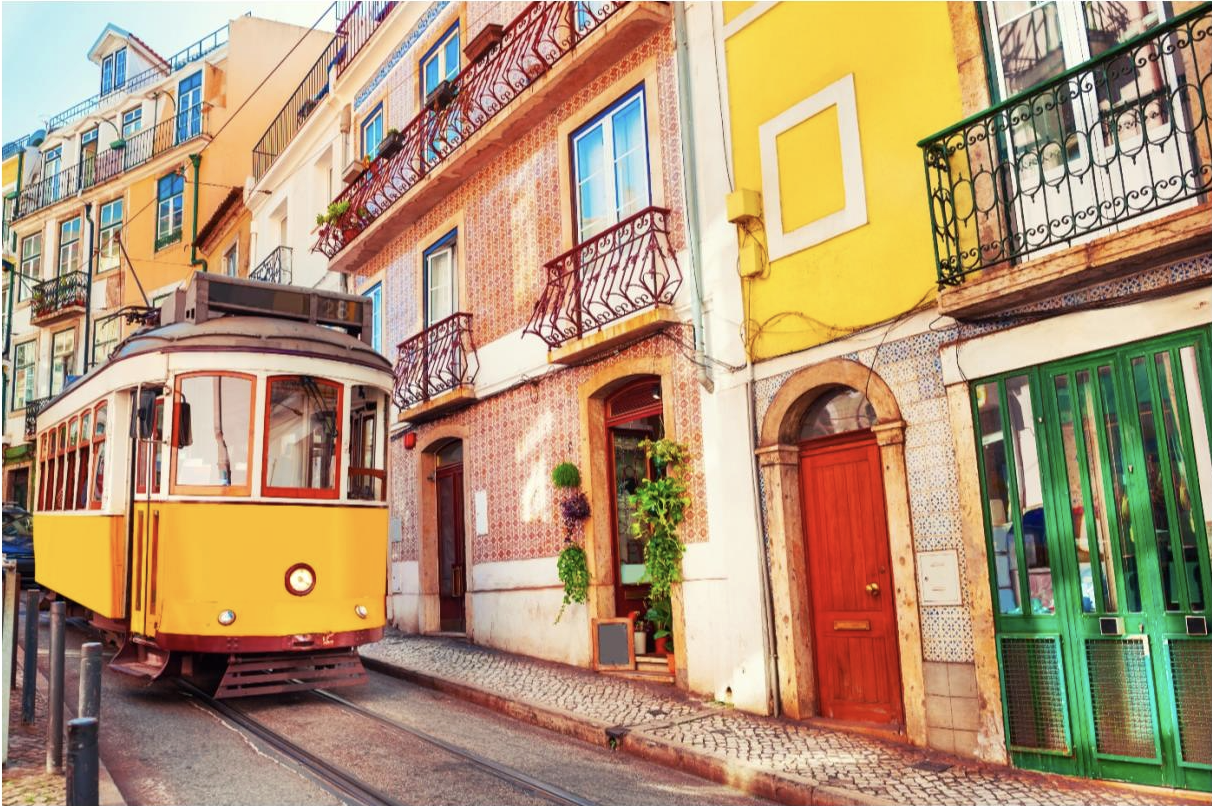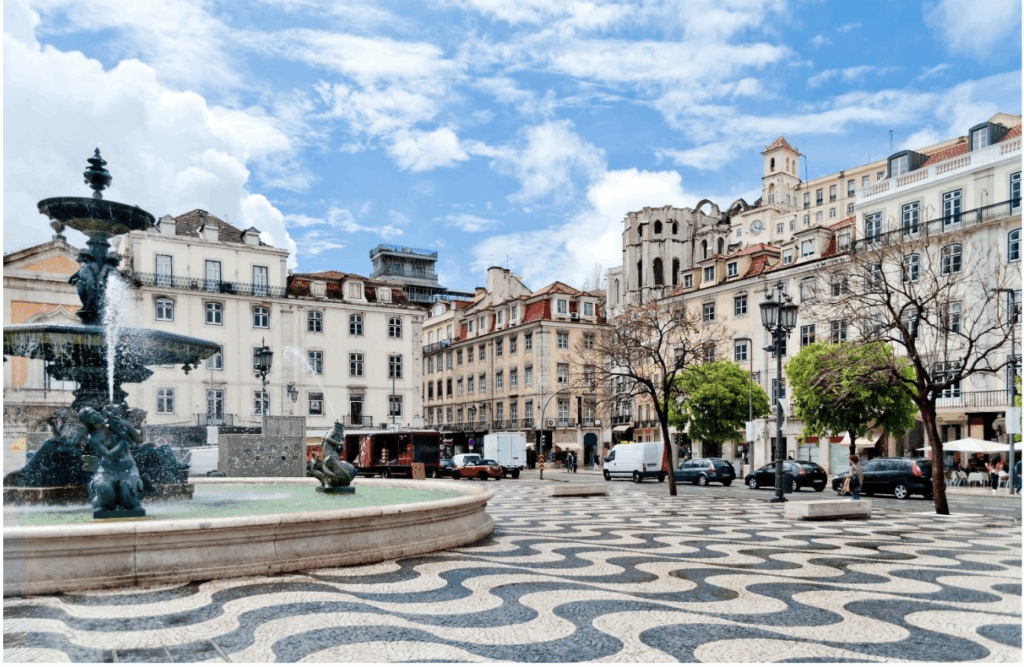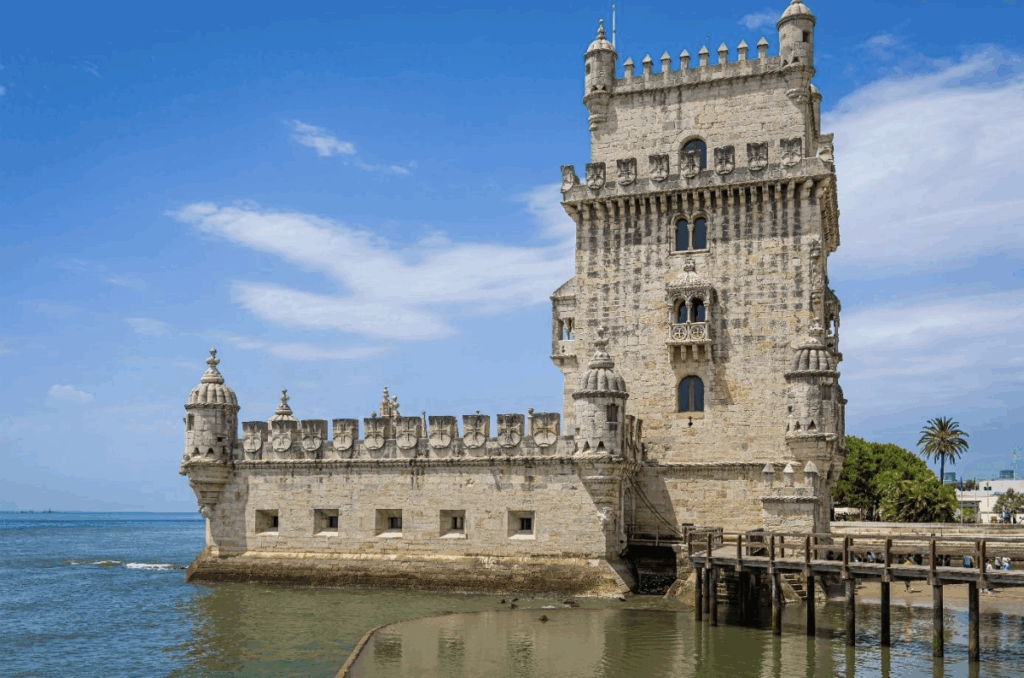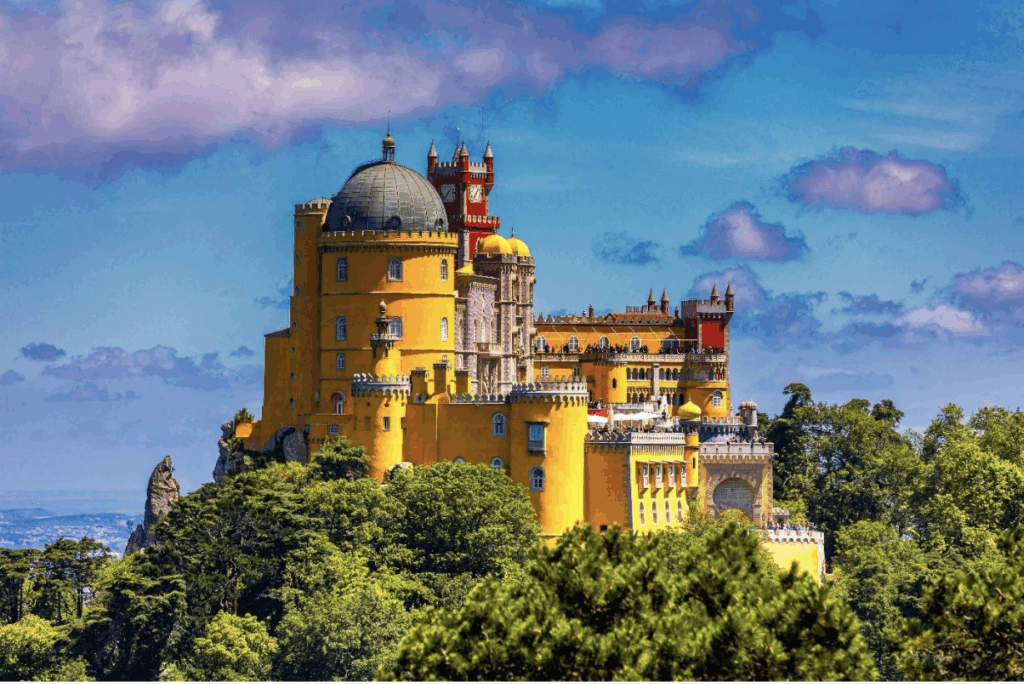
Lisbon, Portugal’s captivating capital, beckons travelers with its golden light, cobblestone streets, and irresistible blend of old-world charm and modern vitality. This enchanting city sprawls across seven hills overlooking the Tagus River, offering visitors a perfect fusion of history, culture, gastronomy, and breathtaking views. Whether you’re planning Lisbon 3 day itinerary adventures or seeking best things to do in Lisbon for an extended stay, this comprehensive guide will help you experience the very essence of Portugal’s remarkable capital city.
Photo credit: Shutterstock.com | Olga Gavrilova
Day One: Historic Heart and Iconic Neighborhoods
Begin your Lisbon Portugal itinerary in the historic Baixa district, the city’s downtown area masterfully rebuilt after the devastating 1755 earthquake. Start at Rossio Square, where locals gather around its distinctive wave-patterned mosaic pavement that creates an optical illusion under the Portuguese sun. From here, stroll down Rua Augusta, the bustling pedestrian shopping street that leads to the magnificent Arco da Rua Augusta. Climb to the top of this triumphal arch for panoramic views of the city and river that showcase why Lisbon ranks among Europe’s most photogenic capitals.
Explore the geometric streets of Baixa, designed by the Marquis of Pombal as one of Europe’s first examples of earthquake-resistant urban planning. The area’s neoclassical architecture and wide avenues provide a striking contrast to the medieval neighborhoods you’ll discover later, establishing the “tale of two cities” theme that defines the Lisbon experience.

Photo credit: Shutterstock.com | Gubin Yury
Next, make your way to Commerce Square or Praça do Comércio, one of Europe’s most beautiful and historically significant squares. This grand waterfront plaza, once the site of the royal palace destroyed in the great earthquake, showcases impressive yellow buildings that house government offices, restaurants, and cultural spaces. The square offers stunning views across the Tagus River and serves as the perfect introduction to Lisbon’s maritime heritage that shaped Portuguese culture for centuries.
Don’t miss the opportunity to ride the historic Santa Justa Elevator, an iron tower designed by Raoul Mesnier du Ponsard, a student of Gustave Eiffel, who designed the Eiffel Tower in Paris. This neo-Gothic structure provides spectacular 360-degree views of the city and represents one of Lisbon’s most unique architectural features. The elevator experience alone justifies its inclusion in any best things to do in Lisbon recommendations.
Dedicate your afternoon to exploring the atmospheric Alfama district, Lisbon’s oldest and most charming neighborhood. This labyrinthine quarter survived the great earthquake and retains its medieval character with narrow alleys, traditional houses adorned with beautiful azulejo tiles, and small squares where locals gather for impromptu conversations and children play football.
Visit the imposing Lisbon Cathedral, known as the Sé de Lisboa, the city’s oldest church dating from 1147, which showcases architectural evolution through Romanesque, Gothic, and Baroque elements. The cathedral’s treasury houses religious artifacts that tell the story of Portuguese spiritual heritage, while its cloisters provide peaceful respite from the bustling streets outside.
Climb up to the Miradouro da Senhora do Monte for breathtaking sunset views that encompass the entire city center, the Tagus River, and the distant 25 de Abril Bridge.
For dinner, immerse yourself in Alfama’s fado culture at one of the traditional restaurants where you can hear Portugal’s soulful national music while savoring authentic Portuguese cuisine. These intimate venues provide cultural experiences that connect visitors to Portuguese artistic heritage while enjoying excellent local wines and traditional dishes.
Day Two: Belém’s Monuments and Culinary Delights
Spend your second day in the Belém district, a treasure trove of Portuguese maritime history and architectural marvels that showcase Portugal’s golden age of exploration. This area represents essential Lisbon travel tips territory, where UNESCO World Heritage sites and culinary traditions combine to create unforgettable experiences.

Start early at the iconic Jerónimos Monastery, a UNESCO World Heritage site and masterpiece of Manueline architecture that celebrates Portugal’s Age of Discovery. This stunning limestone monument, begun in 1501, showcases intricate stone carvings that incorporate maritime motifs, exotic plants, and religious symbols reflecting Portugal’s global explorations. The monastery houses the tomb of explorer Vasco da Gama and poet Luís de Camões, making it a pilgrimage site for those interested in Portuguese history and literature.
The monastery’s cloister represents one of Europe’s most beautiful examples of late Gothic architecture, with delicate stonework that creates play of light and shadow throughout the day. Allow at least two hours to fully appreciate the monastery’s artistic details and historical significance within Portuguese culture.
Walk along the scenic riverfront to the Belém Tower, another UNESCO World Heritage site that served as both a ceremonial gateway to Lisbon and a defensive fortification during the Age of Discovery. This picturesque fortress, built between 1514-1520, has become one of Portugal’s most recognizable landmarks and appears on the country’s euro coins.
Visit the impressive Monument to the Discoveries, or the Padrão dos Descobrimentos, a 52-meter-tall monument shaped like a ship’s prow that honors the Portuguese explorers who launched their world-changing expeditions from this very location. Take the elevator to the top for magnificent river views and aerial perspectives of Belém’s historic district, or admire the giant compass rose mosaic on the ground nearby that maps Portuguese discoveries across the globe.
Lisbon food tours often highlight Belém’s culinary crown jewel: the famous Pastéis de Belém bakery, where the original pastéis de nata have been made using a closely guarded secret recipe since 1837. These warm, flaky pastries with their perfectly caramelized custard centers represent a culinary pilgrimage that food enthusiasts travel thousands of miles to experience.

Conclude your day at the modern Berardo Collection Museum, which houses an impressive collection of contemporary and modern art from international artists, or explore the peaceful Tropical Botanical Garden for a tranquil end to your monument-filled day. These options provide cultural balance and demonstrate Lisbon’s commitment to both preserving heritage and embracing contemporary artistic expression.
Day Three: Hills, Views, and Vibrant Culture
Begin day three in the trendy Chiado and Bairro Alto districts, where historic charm meets contemporary Portuguese lifestyle. Take the iconic Tram 28, which winds through Lisbon’s hills and offers one of the world’s most charming urban transportation experiences. This vintage yellow tram provides moving views of diverse neighborhoods while connecting major attractions in a single scenic journey.
Start in Chiado, known for its elegant shops, traditional cafes, and the beautiful ruins of the Carmo Convent destroyed in the 1755 earthquake. This sophisticated district attracts both locals and visitors with its blend of international brands and Portuguese boutiques, creating a shopping experience that reflects Lisbon’s cosmopolitan character.
The area’s literary heritage includes the famous Café A Brasileira, where Portugal’s national poet Fernando Pessoa spent countless hours writing. A bronze statue of Pessoa sits at his favorite table, creating a popular photo opportunity while honoring Portuguese literary traditions.
Explore the bohemian Bairro Alto, famous for its vibrant nightlife but equally charming during daylight hours. Wander through its grid of narrow streets lined with colorful buildings housing vintage shops, art galleries, and cozy cafes that showcase emerging Portuguese designers and artists.
Culinary Adventures: A Feast for Portuguese Flavors
Lisbon food tours reveal why Portuguese cuisine deserves recognition among Europe’s finest culinary traditions. Start your mornings with a strong café and fresh pastéis de nata at local bakeries.
For lunch, seek out traditional tascas serving hearty portions of bacalhau, or codfish prepared in countless creative ways – locals proudly claim there’s a different bacalhau recipe for every day of the year. These neighborhood restaurants provide authentic dining experiences where visitors can engage with local culture while enjoying generous portions of traditional Portuguese comfort food.
Don’t miss trying caldeirada, a rich seafood stew that showcases Portugal’s maritime heritage, or the iconic francesinha sandwich if you’re feeling adventurous enough to tackle this hearty northern Portuguese creation. Grilled sardines, especially during the summer festivals, provide quintessential Lisbon experiences that connect visitors to the city’s working-class traditions and seaside character.
Pair your meals with vinho verde, a refreshing Portuguese wine perfect for warm afternoons, or sample port wine, the country’s most famous export that demonstrates Portuguese winemaking expertise.
Visit the Time Out Market in Cais do Sodré, where dozens of food vendors offer everything from traditional Portuguese dishes to international cuisine under one beautifully restored historic roof.
Extended Itinerary: Day Trips and Hidden Gems
If your Lisbon 3 day itinerary extends longer, consider exploring Lisbon’s surrounding areas that offer additional cultural and natural attractions. Take a day trip to the fairytale town of Sintra, just 40 minutes away by car, where you can visit the colorful Pena Palace and the mysterious Quinta da Regaleira estate with its initiation wells and secret tunnels.

The dramatic coastline of Cascais offers beautiful beaches and upscale resort atmosphere, while Óbidos presents one of Portugal’s most perfectly preserved medieval towns within its ancient walls. These destinations provide context for understanding Portuguese history and culture beyond the capital city.
Discover Lisbon’s Timeless Appeal
Lisbon captivates visitors with its perfect blend of tradition, stunning architecture, incredible food, and warm hospitality that defines its culture. This Lisbon Portugal itinerary offers a structured introduction to the city’s many facets. Whether you’re following this detailed Lisbon 3 day itinerary or using it as inspiration or a trip combined with Spain, Lisbon promises experiences that will inspire return visits to discover even more of Portugal’s captivating capital.
Let us Design Your Perfect Lisbon Itinerary
At LuxEurope, we specialize in handcrafted, immersive journeys designed to reflect your passions and pace. Whether you have one day or an entire week to explore Lisbon and its surroundings, we’ll design a seamless itinerary full of exclusive access, local flavor, and meaningful encounters.
Contact us to begin designing your tailor-made Portugal adventure today.
